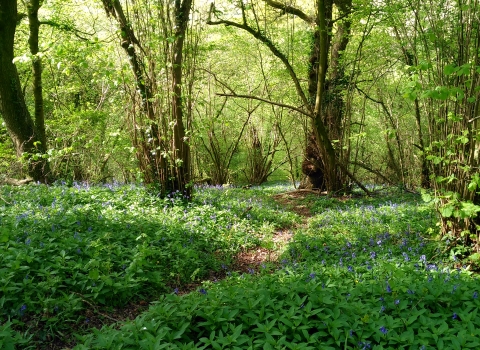Ox-eye Daisy - Cath Shellswell
Prospect Fields
Know before you go
Dogs
Visit the 'Dog walking on reserves' page in the Contact section for more information.
When to visit
Opening times
Open at all timesBest time to visit
April to JulyAbout the reserve
The reserve comprises three fields, two of them towards the west, have a species-rich calcareous grassland flora that contains many characteristic species including Carline Thistle, Pyramidal Orchid, Bee Orchid, Pepper Saxifrage, Hoary Plantain, Yellow-Wort, Common Centuary, Small-flowered Buttercup, Wild Thyme and Quaking Grass. These fields also contain several plant species that have a very restricted distribution in Somerset such as Common Hound’s-Tongue and Dodder. Corn Parsley, a species that is declining not only nationally but also in Europe, is also present along with the nationally scarce Slender Tare.
The field that lies to the east and closest to the entrance is not so species rich being dominated by grasses especially Timothy Grass, Smooth Meadow-grass and Meadow Fescue. Herbs present include White Clover, Agrimony, Black Medick, Bird’s-foot Trefoil, Wild Carrot and Wall Speedwell. Ox-eye Daisy is locally abundant. The fields are surrounded by a very wide hedgerows with abundant Elm, Hawthorn, Blackthorn and Elder. Broad bands of fragmented scrub, which are derived from former hedgerows, divide the fields, while other small scattered patches of scrub also occur across the reserve.
The dense hedgerows provide great nesting places for Blackcaps, Long Tailed Tits and many other small birds. Green Woodpeckers are seen regularly in the fields probing into ant hills to feed on ants and their larvae. Buzzards and Kestrels are seen overhead throughout the year. Badgers are resident and there is a large Rabbit population.
A good range of butterflies can be found here including the Brown Hairstreak whose caterpillars feed on the Blackthorn in the hedges and also Small Copper, Holly Blue, Brown Argus, Common Blue, Ringlet, Hedge Brown, Small Heath, Marble White and Small Skipper. The Dingy Skipper and Wall butterfly have also been recorded here. The Great Green Bush-Cricket can also be seen here.
Reserve conservation management – Livestock grazing. Rotational cutting of scrub to stop it encroaching on the grassland.



